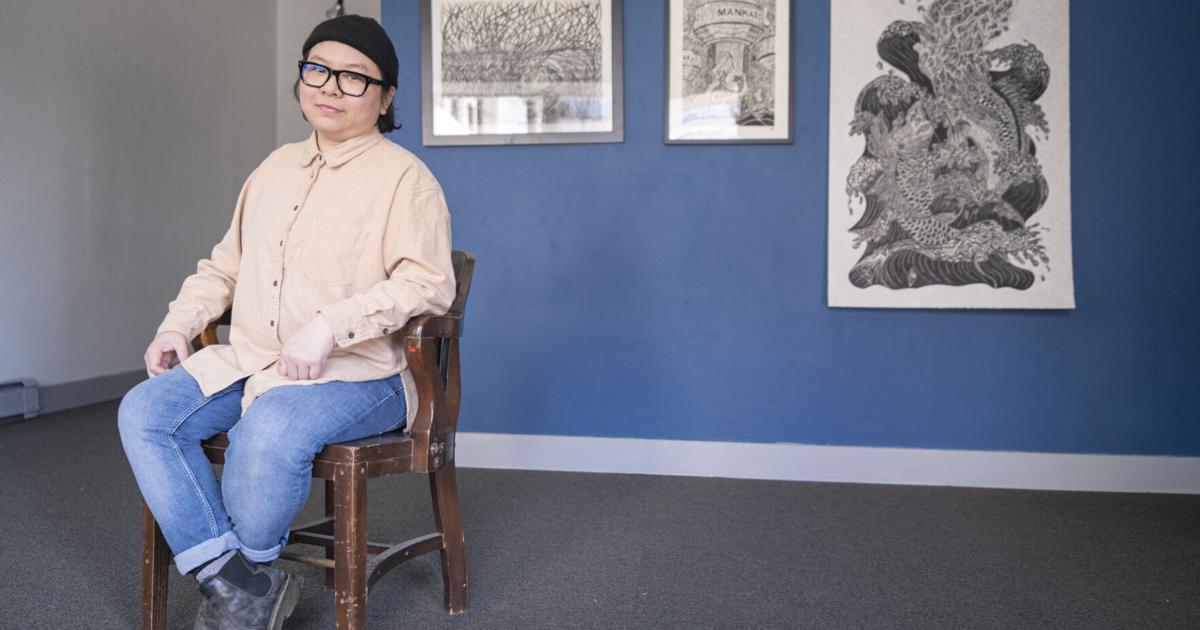
#inform-video-player-1 .inform-embed { margin-top: 10px; margin-bottom: 20px; }
#inform-video-player-2 .inform-embed { margin-top: 10px; margin-bottom: 20px; }
Illuminated by natural sunlight, Mai Tran hovers over her latest work, gently brushing away excess shavings from her latest woodcut print.
Tran uses knives and other tools to carve designs into the surfaces of wooden blocks. It’s the oldest form of printmaking and the form the 34-year-old artist fell deeply in love with during her days at Minnesota State University.
Tran took her first relief printmaking class in 2018 and was instantly drawn to the process and the look of woodcut prints. The process itself was invented in ninth century China. Once the carving is done, the artist rolls ink over the carved wood, followed by the laying of paper or fabric over the inked block.
The block — with the paper or fabric on top — is then sent through a drum press or hand pressed with a flat object, which transfers the ink to the paper or fabric.
Multiple original artworks can be made from one completed block — an aspect of the craft that Tran heavily values because the originals can be preserved for many years, ensuring that future generations can enjoy the prints as well.
“I also like that I can utilize such an ancient medium to create contemporary art, as well as the community aspects of it,” Tran said. “Woodcut is accessible, and you can make art anywhere you want.”
If Tran, now an MFA student at the University of Minnesota, hadn’t come to the United States from Vietnam as an international student in 2015, she says she may have never found her calling.
Originally, Tran planned to major in biology and minor in graphic design upon completion of MSU’s intensive English as a second language program. But after taking a handful of graphic design classes and thoroughly enjoying them, Tran declared it her major instead.
She didn’t stop there, however.
“I took an introduction to printmaking course and I totally fell for it. That’s when I made the big decision to completely switch to printmaking and to be an artist.”
She hasn’t looked back since.
“The experiences I’ve had while studying abroad in the U.S. are unforgettable,” Tran said, adding she hopes to one day make the U.S. her permanent home.
If an opportunity to grow professionally as an artist in Vietnam presents itself, however, Tran said she would consider moving back because she misses her family, her mom’s cooking, street food, the “beautiful landscape” and overall “rich culture.”
Regardless of where Tran resides, she has found a way to incorporate both American and Vietnamese culture into her artwork.
“My prints are inspired from Vietnamese culture, mythology, history, my family and a fresh touch of American pop culture,” she said. “Through research and personal experience, I pick and choose what could be a match for my mixed Vietnamese-American works, including the differences between landmarks, seasons, idealization, consumerism and more.”
Tran uses memories of her family, specifically those of her mom, to get inspired. Her family, however, hasn’t always been her biggest fan.
“My family is not fond of me going the artist way. They care a lot about me and are worried about me not being able to make a living off my art.”
Tran has been on a mission to prove them wrong.
“I’ve always wanted to be an artist ever since I was little. Of course I can do other things, but I wouldn’t feel as happy as I am now.”
As a person of color, Tran also deems it important to represent her community whenever she can.
“I want to show that no matter what your background is, your artistic voice is important.”
Since graduating from MSU with a bachelor’s degree in printmaking and photography, Tran has been a frequent presence at the 410 Project as an exhibiting artist and volunteer. Prior, she was a regular visitor.
“I visited the 410 Project many times when I was an art student at MSU. I really liked that their mission involved creating a safe art space for the community.”
Tran began volunteering at the gallery in the fall of 2021 and began entering her artwork into community shows, which eventually led to her first solo exhibition in the U.S.
Dana Sikkila, director of the 410 Project, said she was initially impressed by Tran’s artistic storytelling and commitment to the Mankato community.
“She’s helped cover gallery hours, photograph events and helped with other programming,” Sikkila said. “Over the years, Mai has taken on more responsibility at the space and loves bringing new ideas to the gallery and our community.”
Despite Tran currently living in Minneapolis while completing her master’s degree, she travels to Mankato every couple of weeks to work on her ongoing projects at the gallery. One of which she shares with Sikkila.
“Just this year, Mai and I developed 410 Studios,” Sikkila said, “a video storytelling project with artists at the forefront. It shares upcoming displaying artists’ stories in an intimate 4 minutes and 10 seconds.”
Tran is also busy preparing for her upcoming solo exhibition at the Paradise Center for the Arts in Faribault, running June 3-July 6.
Sikkila applauds Tran’s ambition.
“I admire many things about Mai, but one thing that stands out to me is her passion for her work and the support she gives the artists around her,” she said. “You will never find Mai just static. She’s always moving, working and pushing herself. She uses every opportunity she can get and doesn’t waste it.”
Tran attests her ambition to the belief that “It’s very easy to stop making art, so you have to believe in yourself and keep working.”
For the foreseeable future, Tran says she plans to do just that by using a traditional process to tell contemporary narratives for others to enjoy.
#inform-video-player-3 .inform-embed { margin-top: 10px; margin-bottom: 20px; }
